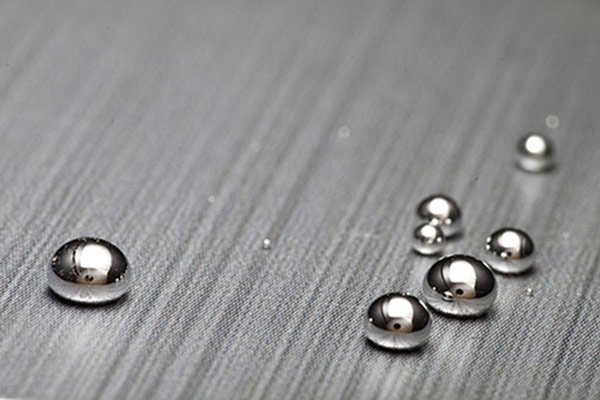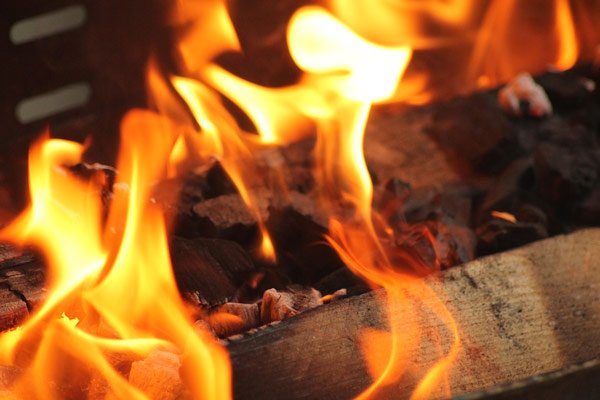Why is water wet, fire hot?
We are always aware that wet, fire water creates heat that causes heat. But what makes wet and hot fire? Probably not all of us wonder about this.
The answer to this seemingly silly question will be in the article below.
Why is water wet?
Below is an answer to the question 'why is wet water' posted on the University of California, Santa Barbara (UCSB) website.
Water is a liquid, which can make other solid materials get wet, but it does not get wet.
Humidity is the ability of a liquid to attach to a solid surface. When the liquid sticks to the surface of the material, it is wet.

A wet or dry object depends on the balance between the adhesive force (two different things stick together) and the binding force (the two things together stick together).
The binding force is the gravitational force in a liquid, which causes molecules in the liquid to stick together. The cohesion and surface tension of the object are related. If the force is strong, the molecules in the liquid are very close together, which prevents them from spreading on the surface of an object. Sticky force is the gravitational force between material surface and liquid. If the adhesive force is strong, the liquid will spread to the surface.
Therefore, the balance between these two forces will determine how wet the surface of the object is.
- If the bonding force (liquid-liquid) is weaker than the adhesive force (liquid-solid): The material is wet and the fluid is spreading trying to maximize contact with the surface.
- If the binding force (liquid-liquid) is greater than the adhesive force (liquid-solid): The material will not get wet (dry), the fluid has a tendency to form a spherical droplet, minimizing contact. .
Water actually has hydrogen bonding so it has a high binding force. Therefore, compared with some liquids such as acetone or alcohol, the ability to wet the surface of the water is worse. There are even liquids that do not wet the material, such as mercury.

When detergent is added, the binding force of the water decreases, making it better at wetting.
The above helps us explain why liquid is also, but water, cooking oil, milk . have different wetting levels.
Why is fire hot?

According to Thoght.co, during the burning process, the chemical bonds are broken down and formed, releasing heat energy. Burning causes oxygen and fuel to turn into carbon dioxide and water. For the reaction to take place it takes energy to break the bond between oxygen atoms and in the fuel. When atoms bind together into carbon dioxide and water, more energy is released.

Both light and heat are released as energy and exist as flames. Flames emit from ionized gases and embers emit by material hot enough to emit incandescent light.
In short, the energy stored in the fuel is suddenly released causing the fire to heat. The energy released is much more than the energy needed to initiate a chemical reaction.
- Scientists have successfully created a "reverse solar cell" that generates electricity in the dark
- What bad thing would happen to Earth if the sea was no longer salty?
You should read it
- The police instructed to extinguish the fire when the gas tank was on fire
- 5 ways to create fire from simple to unexpected items
- How fast can a fire spread?
- Instructions for setting up auto-fire of Fire VNG
- Admire the magic 'dancing' pillar of fire in the rare sulfur fire
- The 11th-12th-century church was destroyed by fire and unearthed at Pisidia
- What is fire? Material or energy?
- 'Terrible' fire sprinkler gun penetrates concrete walls, iron doors
May be interested
- Top 4 best selling hot and cold water plants today
 hot and cold water plants are premium products for families, schools and offices. hot and cold water can both heat water and cool water. if you are looking to buy the best hot and cold water plants, you should not ignore the top 4 hot and cold water plants below.
hot and cold water plants are premium products for families, schools and offices. hot and cold water can both heat water and cool water. if you are looking to buy the best hot and cold water plants, you should not ignore the top 4 hot and cold water plants below. - Top 5 best water toothpick machines today
 water swab is an effective oral care product for braces, porcelain teeth, dentures. top 5 best water toothpicks today will be helpful suggestions for those who need to buy water dispensers.
water swab is an effective oral care product for braces, porcelain teeth, dentures. top 5 best water toothpicks today will be helpful suggestions for those who need to buy water dispensers. - Water will become 'poison' if taken at 5 times later
 drinking water daily is a necessary task for the human body. however, it is not always good and beneficial to drink water. here are 5 times you should not drink water if you do not want water to become toxic.
drinking water daily is a necessary task for the human body. however, it is not always good and beneficial to drink water. here are 5 times you should not drink water if you do not want water to become toxic. - Instructions for playing Martyrs VNG for newbies
 instructions for how to play fire vng for newbies, including mission system, equipment upgrades, skills, character stats, ... help you more easily capture the game.
instructions for how to play fire vng for newbies, including mission system, equipment upgrades, skills, character stats, ... help you more easily capture the game. - Is fire a solid, liquid, gas or plasma?
 fire is actually not physical at all but is the human sensory experience of a chemical reaction called combustion.
fire is actually not physical at all but is the human sensory experience of a chemical reaction called combustion. - Get water into your ear after swimming properly according to expert's instructions
 water is easy to flow into the ears when we bathe or go swimming to cause tinnitus, hearing loss and earache. if stagnant water in the ear for a long time can lead to ear infections, earwax and dirt. so, how is the right and safest way to get water into the ear?
water is easy to flow into the ears when we bathe or go swimming to cause tinnitus, hearing loss and earache. if stagnant water in the ear for a long time can lead to ear infections, earwax and dirt. so, how is the right and safest way to get water into the ear? - What is the best RO water purifier?
 ro water purifier for ultra-pure, pure water purification, can be taken without boiling. the following 3 samples of ro water purifiers are the best products to choose from.
ro water purifier for ultra-pure, pure water purification, can be taken without boiling. the following 3 samples of ro water purifiers are the best products to choose from. - Instructions to receive The Burning Leo package in Free Fire
 instructions for receiving the burning leo package in free fire, instructions for receiving gift packages in free fire's new faded wheel - the burning leo and golden roar gun skin
instructions for receiving the burning leo package in free fire, instructions for receiving gift packages in free fire's new faded wheel - the burning leo and golden roar gun skin - Should I use a water cleaner?
 the selection of suitable and safe oral care products is very important. water purifiers are recommended by many dental professionals. so is it really effective to use water toothpicks?
the selection of suitable and safe oral care products is very important. water purifiers are recommended by many dental professionals. so is it really effective to use water toothpicks? - Popular tactics in Free Fire
 when playing garena free fire, gamers will encounter fairly common tactics and often apply until the end of the game.
when playing garena free fire, gamers will encounter fairly common tactics and often apply until the end of the game.










 Cordyceps what cure?
Cordyceps what cure? To reduce the risk of myopia, let your children play outside for at least 1 hour a day
To reduce the risk of myopia, let your children play outside for at least 1 hour a day Does using induction hob affect health?
Does using induction hob affect health? What bad thing would happen to Earth if the sea was no longer salty?
What bad thing would happen to Earth if the sea was no longer salty? 10 species of land predatory fish in the natural world
10 species of land predatory fish in the natural world Water bottles are safe for your health? Glass bottles, plastic bottles or metal bottles?
Water bottles are safe for your health? Glass bottles, plastic bottles or metal bottles?